tow Citroen C4 AIRCROSS 2014 1.G Owner's Guide
[x] Cancel search | Manufacturer: CITROEN, Model Year: 2014, Model line: C4 AIRCROSS, Model: Citroen C4 AIRCROSS 2014 1.GPages: 368, PDF Size: 20.37 MB
Page 157 of 368
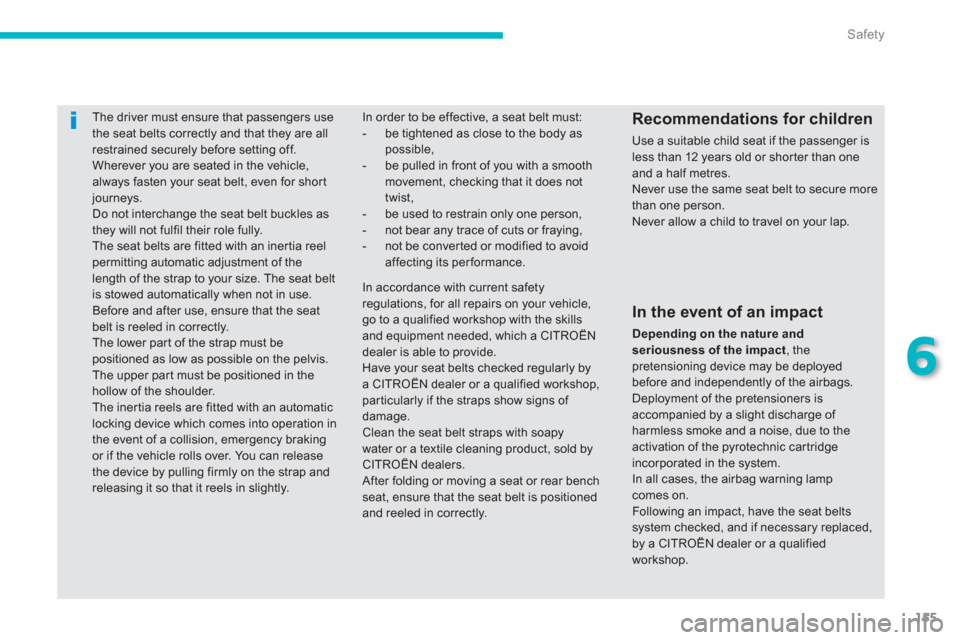
155
6
Safety
The driver must ensure that passengers use
the seat belts correctly and that they are all
restrained securely before setting off.
Wherever you are seated in the vehicle,
always fasten your seat belt, even for short
journeys.
Do not interchange the seat belt buckles as
they will not fulfil their role fully.
The seat belts are fitted with an inertia reel
permitting automatic adjustment of the
length of the strap to your size. The seat belt
is stowed automatically when not in use.
Before and after use, ensure that the seat
belt is reeled in correctly.
The lower part of the strap must be
positioned as low as possible on the pelvis.
The upper part must be positioned in the
hollow of the shoulder.
The inertia reels are fitted with an automatic
locking device which comes into operation in
the event of a collision, emergency braking
or if the vehicle rolls over. You can release
the device by pulling firmly on the strap and
releasing it so that it reels in slightly.
Recommendations for children
Use a suitable child seat if the passenger is
less than 12 years old or shorter than one
and a half metres.
Never use the same seat belt to secure more
than one person.
Never allow a child to travel on your lap. In order to be effective, a seat belt must:
- be tightened as close to the body as
possible,
- be pulled in front of you with a smooth
movement, checking that it does not
twist,
- be used to restrain only one person,
- not bear any trace of cuts or fraying,
- not be converted or modified to avoid
affecting its per formance.
In the event of an impact
Depending on the nature and
seriousness of the impact
, the
pretensioning device may be deployed
before and independently of the airbags.
Deployment of the pretensioners is
accompanied by a slight discharge of
harmless smoke and a noise, due to the
activation of the pyrotechnic cartridge
incorporated in the system.
In all cases, the airbag warning lamp
comes on.
Following an impact, have the seat belts
system checked, and if necessary replaced,
by a CITROËN dealer or a qualified
workshop.
In accordance with current safety
regulations, for all repairs on your vehicle,
go to a qualified workshop with the skills
and equipment needed, which a CITROËN
dealer is able to provide.
Have your seat belts checked regularly by
a CITROËN dealer or a qualified workshop,
particularly if the straps show signs of
damage.
Clean the seat belt straps with soapy
water or a textile cleaning product, sold by
CITROËN dealers.
After folding or moving a seat or rear bench
seat, ensure that the seat belt is positioned
and reeled in correctly.
Page 158 of 368
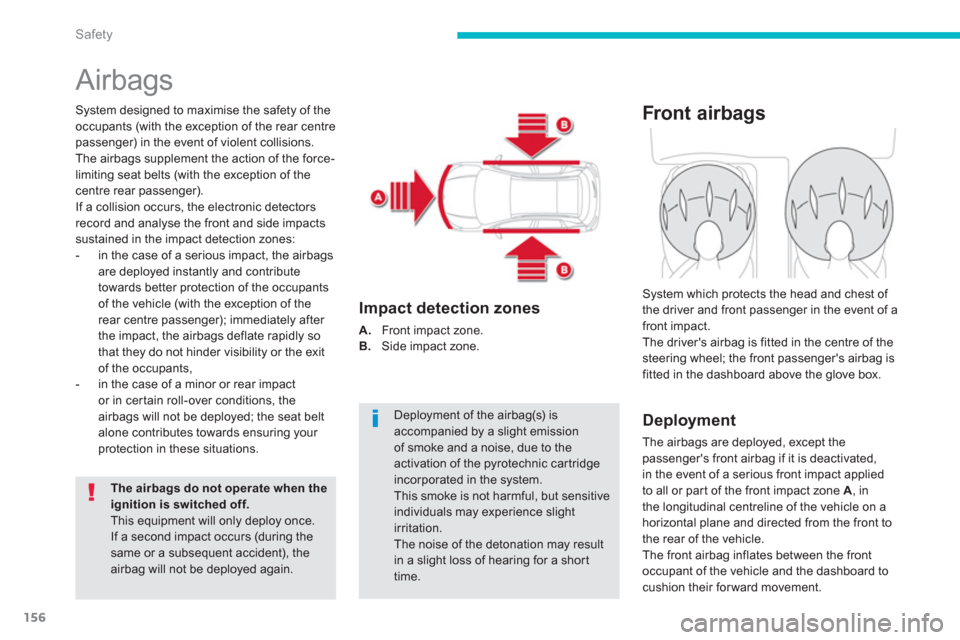
156
Safety
Airbags
System designed to maximise the safety of the
occupants (with the exception of the rear centre
passenger) in the event of violent collisions.
The airbags supplement the action of the force-
limiting seat belts (with the exception of the
centre rear passenger).
If a collision occurs, the electronic detectors
record and analyse the front and side impacts
sustained in the impact detection zones:
- in the case of a serious impact, the airbags
are deployed instantly and contribute
towards better protection of the occupants
of the vehicle (with the exception of the
rear centre passenger); immediately after
the impact, the airbags deflate rapidly so
that they do not hinder visibility or the exit
of the occupants,
- in the case of a minor or rear impact
or in certain roll-over conditions, the
airbags will not be deployed; the seat belt
alone contributes towards ensuring your
protection in these situations.
The airbags do not operate when the
ignition is switched off.
This equipment will only deploy once.
If a second impact occurs (during the
same or a subsequent accident), the
airbag will not be deployed again. Deployment of the airbag(s) is
accompanied by a slight emission
of smoke and a noise, due to the
activation of the pyrotechnic cartridge
incorporated in the system.
This smoke is not harmful, but sensitive
individuals may experience slight
irritation.
The noise of the detonation may result
in a slight loss of hearing for a short
time.
Impact detection zones
A.
Front impact zone.
B.
Side impact zone.
Front airbags
Deployment
The airbags are deployed, except the
passenger's front airbag if it is deactivated,
in the event of a serious front impact applied
to all or part of the front impact zone A
, in
the longitudinal centreline of the vehicle on a
horizontal plane and directed from the front to
the rear of the vehicle.
The front airbag inflates between the front
occupant of the vehicle and the dashboard to
cushion their for ward movement. System which protects the head and chest of
the driver and front passenger in the event of a
front impact.
The driver's airbag is fitted in the centre of the
steering wheel; the front passenger's airbag is
fitted in the dashboard above the glove box.
Page 160 of 368
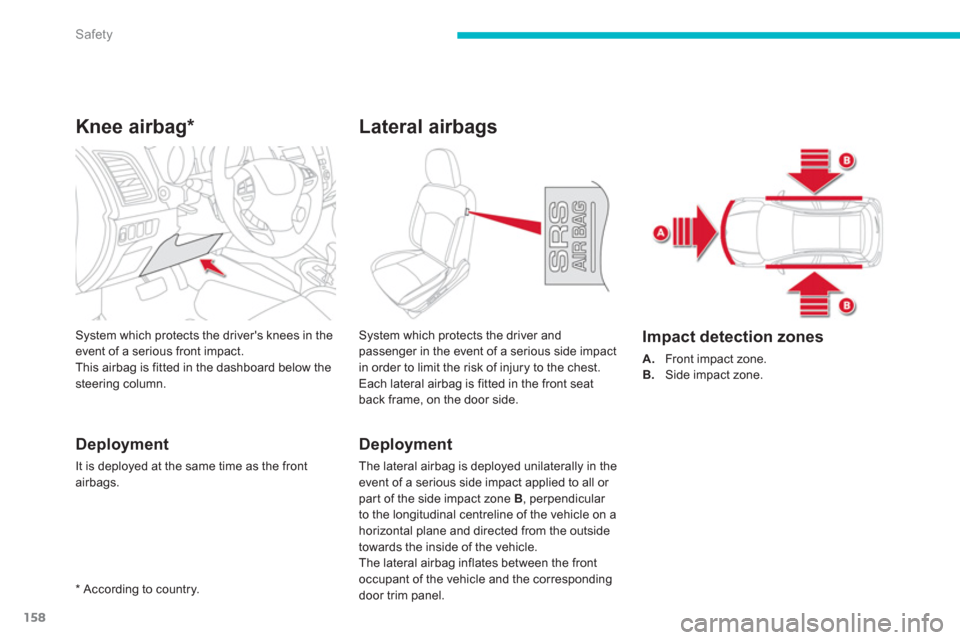
158
Safety
Knee airbag *
Deployment
It is deployed at the same time as the front
airbags.
System which protects the driver's knees in the
event of a serious front impact.
This airbag is fitted in the dashboard below the
steering column. System which protects the driver and
passenger in the event of a serious side impact
in order to limit the risk of injury to the chest.
Each lateral airbag is fitted in the front seat
back frame, on the door side.
Deployment
The lateral airbag is deployed unilaterally in the
event of a serious side impact applied to all or
part of the side impact zone B
, perpendicular
to the longitudinal centreline of the vehicle on a
horizontal plane and directed from the outside
towards the inside of the vehicle.
The lateral airbag inflates between the front
occupant of the vehicle and the corresponding
door trim panel.
Impact detection zones
A.
Front impact zone.
B.
Side impact zone.
*
According to country.
Lateral airbags
Page 161 of 368
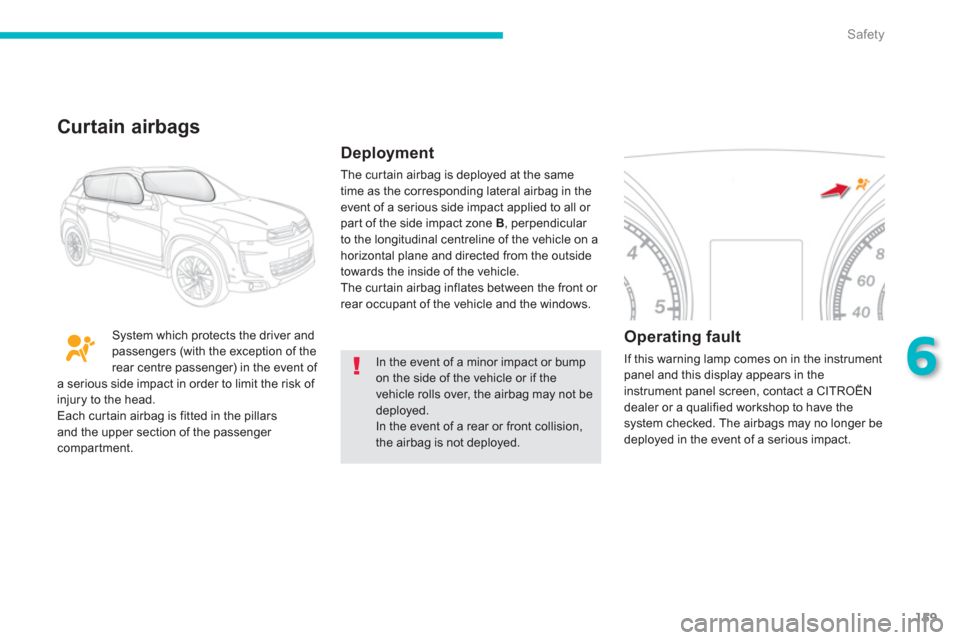
159
6
Safety
In the event of a minor impact or bump
on the side of the vehicle or if the
vehicle rolls over, the airbag may not be
deployed.
In the event of a rear or front collision,
the airbag is not deployed. System which protects the driver and
passengers (with the exception of the
rear centre passenger) in the event of
a serious side impact in order to limit the risk of
injury to the head.
Each curtain airbag is fitted in the pillars
and the upper section of the passenger
compartment.
Curtain airbags
Deployment
The curtain airbag is deployed at the same
time as the corresponding lateral airbag in the
event of a serious side impact applied to all or
part of the side impact zone B
, perpendicular
to the longitudinal centreline of the vehicle on a
horizontal plane and directed from the outside
towards the inside of the vehicle.
The curtain airbag inflates between the front or
rear occupant of the vehicle and the windows.
Operating fault
If this warning lamp comes on in the instrument
panel and this display appears in the
instrument panel screen, contact a CITROËN
dealer or a qualified workshop to have the
system checked. The airbags may no longer be
deployed in the event of a serious impact.
Page 171 of 368
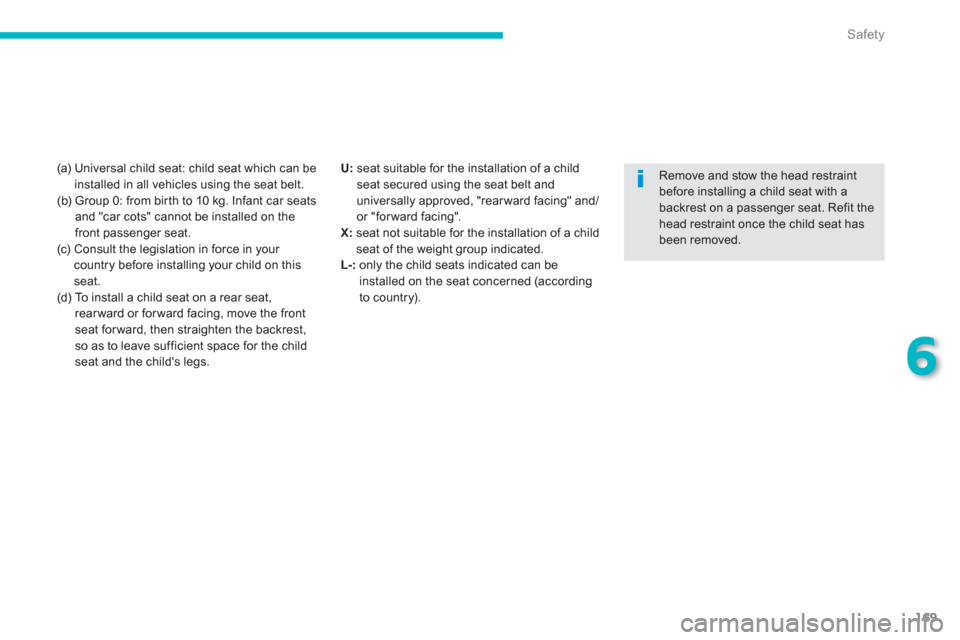
169
6
Safety
(a) Universal child seat: child seat which can be
installed in all vehicles using the seat belt.
(b) Group 0: from birth to 10 kg. Infant car seats
and "car cots" cannot be installed on the
front passenger seat.
(c) Consult the legislation in force in your
country before installing your child on this
seat.
(d) To install a child seat on a rear seat,
rear ward or for ward facing, move the front
seat for ward, then straighten the backrest,
so as to leave sufficient space for the child
seat and the child's legs.
Remove and stow the head restraint
before installing a child seat with a
backrest on a passenger seat. Refit the
head restraint once the child seat has
been removed.
U:
seat suitable for the installation of a child
seat secured using the seat belt and
universally approved, "rear ward facing" and/
or "forward facing".
X:
seat not suitable for the installation of a child
seat of the weight group indicated.
L-:
only the child seats indicated can be
installed on the seat concerned (according
to country).
Page 173 of 368
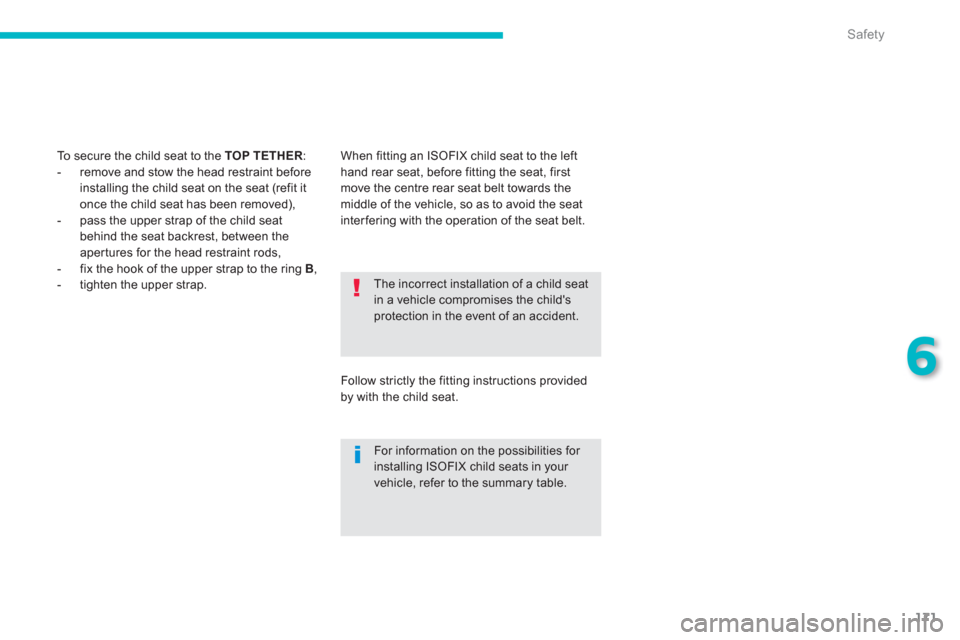
171
6
Safety
The incorrect installation of a child seat
in a vehicle compromises the child's
protection in the event of an accident.
For information on the possibilities for
installing ISOFIX child seats in your
vehicle, refer to the summary table. To secure the child seat to the TOP TETHER
:
- remove and stow the head restraint before
installing the child seat on the seat (refit it
once the child seat has been removed),
- pass the upper strap of the child seat
behind the seat backrest, between the
apertures for the head restraint rods,
- fix the hook of the upper strap to the ring B
,
- tighten the upper strap. When fitting an ISOFIX child seat to the left
hand rear seat, before fitting the seat, first
move the centre rear seat belt towards the
middle of the vehicle, so as to avoid the seat
inter fering with the operation of the seat belt.
Follow strictly the fitting instructions provided
by with the child seat.
Page 176 of 368
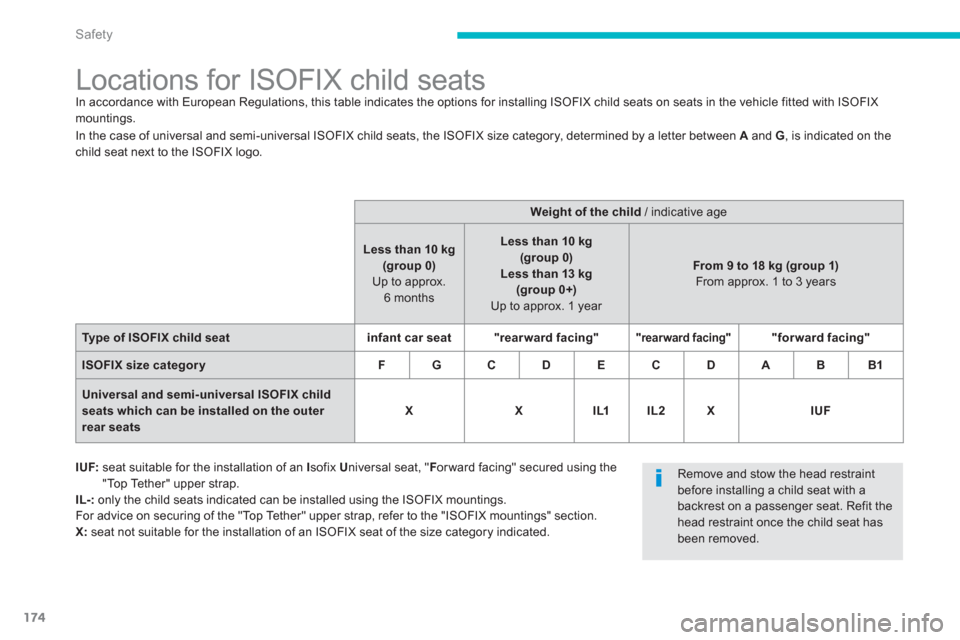
174
Safety
Locations for ISOFIX child seats
In accordance with European Regulations, this table indicates the options for installing ISOFIX child seats on seats in the vehicle fitted with ISOFIX
mountings.
In the case of universal and semi-universal ISOFIX child seats, the ISOFIX size category, determined by a letter between A
and G
, is indicated on the
child seat next to the ISOFIX logo.
Weight of the child
/ indicative age
Less than 10 kg
(group 0)
Up to approx.
6 months
Less than 10 kg
(group 0)
Less than
13 kg
(group 0+)
Up to approx. 1 year
From 9 to 18 kg (group 1)
From approx. 1 to 3 years
Type of ISOFIX child seat
infant car seat
"
rearward
facing"
"
rearward
facing"
"forward facing"
ISOFIX size category
F
G
C
D
E
C
D
A
B
B1
Universal and semi-universal ISOFIX child
seats which can be installed on the outer
rear seat
s
X
X
IL1
IL2
X
IUF
IUF:
seat suitable for the installation of an I
sofix U
niversal seat, " F
or ward facing" secured using the
"Top Tether" upper strap.
IL-:
only the child seats indicated can be installed using the ISOFIX mountings.
For advice on securing of the "Top Tether" upper strap, refer to the "ISOFIX mountings" section.
X:
seat not suitable for the installation of an ISOFIX seat of the size category indicated.
Remove and stow the head restraint
before installing a child seat with a
backrest on a passenger seat. Refit the
head restraint once the child seat has
been removed.
Page 178 of 368
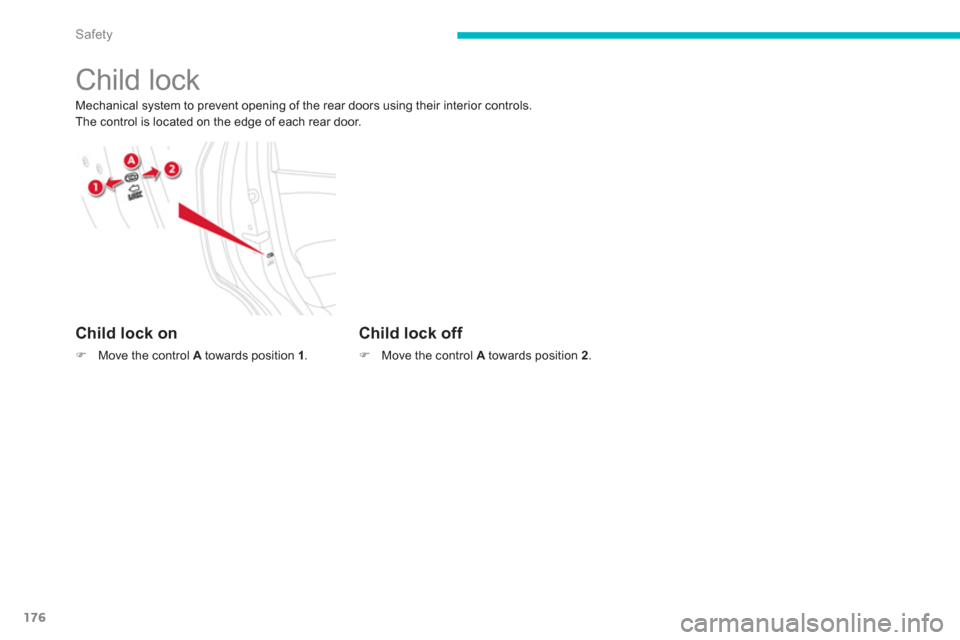
176
Safety
Child lock
Mechanical system to prevent opening of the rear doors using their interior controls.
The control is located on the edge of each rear door.
Child lock on
�)
Move the control A
towards position 1
.
Child lock off
�)
Move the control A
towards position 2
.
Page 182 of 368
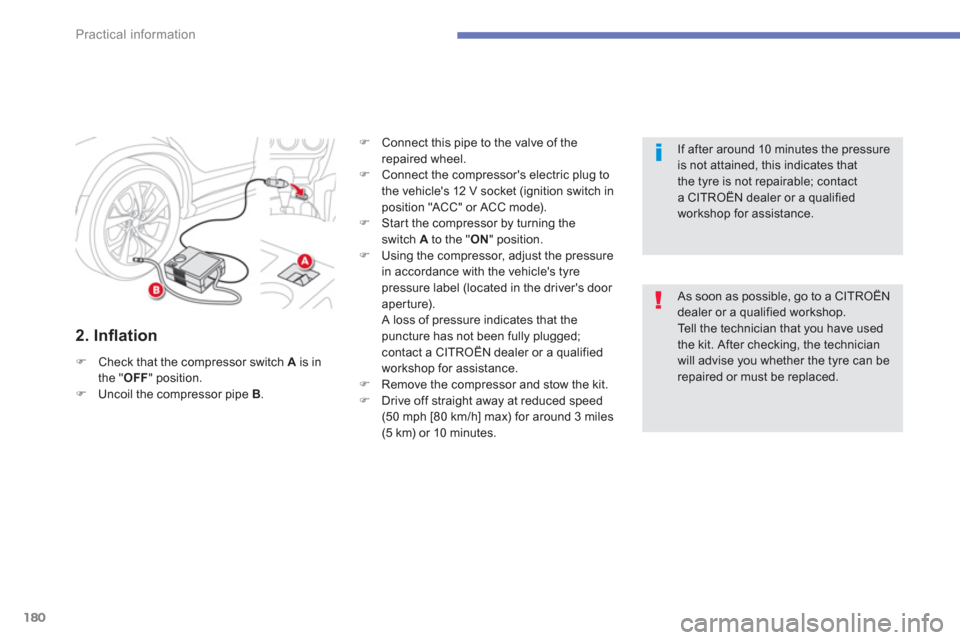
180
Practical information
2. Infl ation
�)
Check that the compressor switch A
is in
the " OFF
" position.
�)
Uncoil the compressor pipe B
.
�)
Connect this pipe to the valve of the
repaired wheel.
�)
Connect the compressor's electric plug to
the vehicle's 12 V socket (ignition switch in
position "ACC" or ACC mode).
�)
Start the compressor by turning the
switch A
to the " ON
" position.
�)
Using the compressor, adjust the pressure
in accordance with the vehicle's tyre
pressure label (located in the driver's door
aperture).
A loss of pressure indicates that the
puncture has not been fully plugged;
contact a CITROËN dealer or a qualified
workshop for assistance.
�)
Remove the compressor and stow the kit.
�)
Drive off straight away at reduced speed
(50 mph [80 km/h] max) for around 3 miles
(5 km) or 10 minutes.
As soon as possible, go to a CITROËN
dealer or a qualified workshop.
Tell the technician that you have used
the kit. After checking, the technician
will advise you whether the tyre can be
repaired or must be replaced.
If after around 10 minutes the pressure
is not attained, this indicates that
the tyre is not repairable; contact
a CITROËN dealer or a qualified
workshop for assistance.
Page 183 of 368
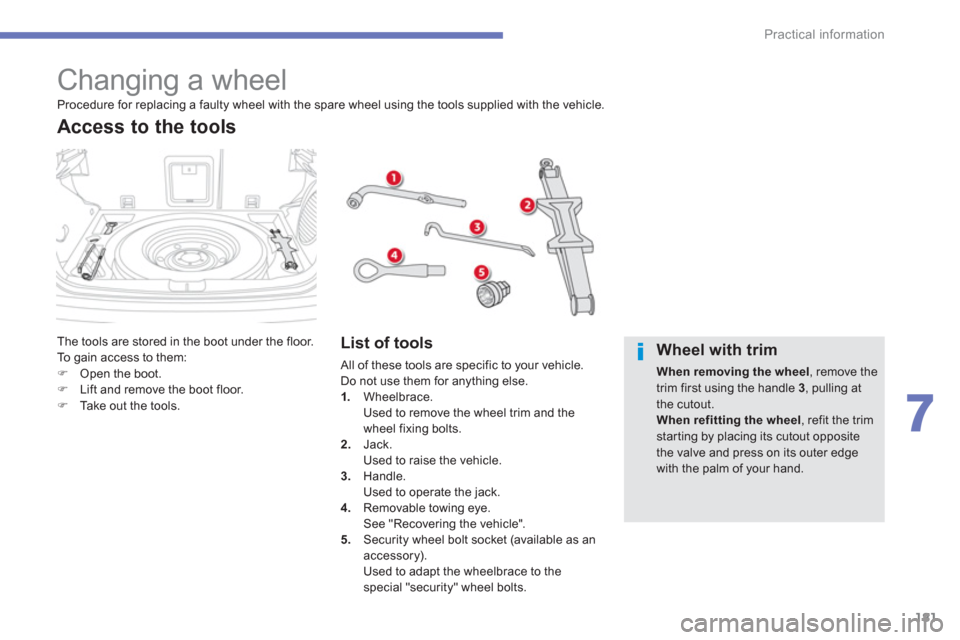
181
7
Practical information
Changing a wheel
The tools are stored in the boot under the floor.
To gain access to them:
�)
Open the boot.
�)
Lift and remove the boot floor.
�)
Take out the tools.
Access to the tools
List of tools
All of these tools are specific to your vehicle.
Do not use them for anything else.
1.
Wheelbrace.
Used to remove the wheel trim and the
wheel fixing bolts.
2.
Jack.
Used to raise the vehicle.
3.
Handle.
Used to operate the jack.
4.
Removable towing eye.
See "Recovering the vehicle".
5.
Security wheel bolt socket (available as an
accessory).
Used to adapt the wheelbrace to the
special "security" wheel bolts.
Procedure for replacing a faulty wheel with the spare wheel using the tools supplied with the vehicle.
Wheel with trim
When removing the wheel
, remove the
trim first using the handle 3
, pulling at
the cutout.
When refitting the wheel
, refit the trim
starting by placing its cutout opposite
the valve and press on its outer edge
with the palm of your hand.